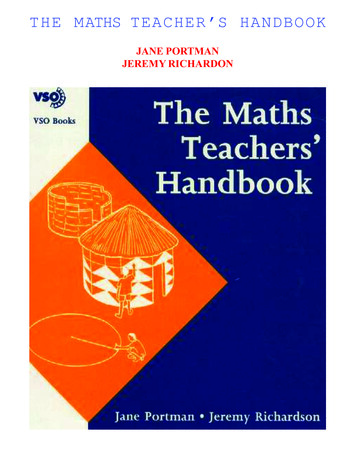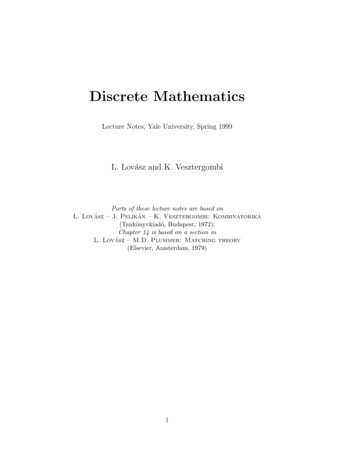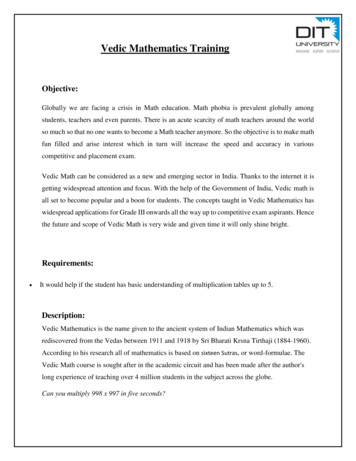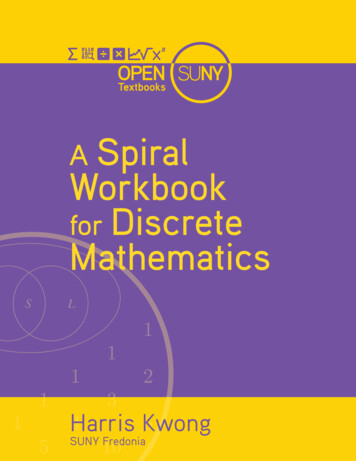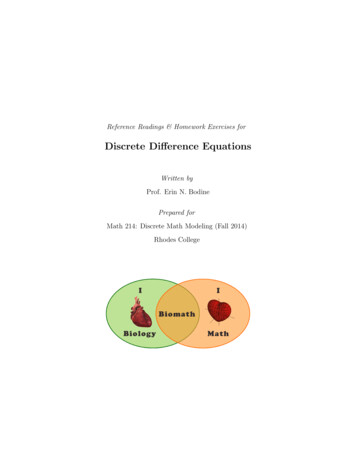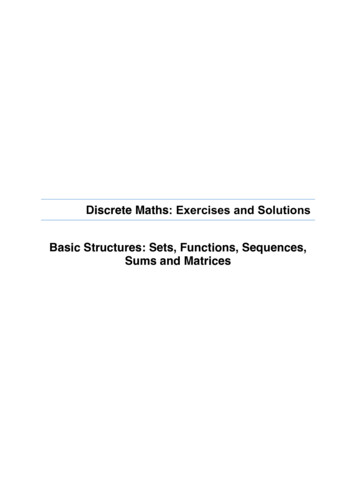
Transcription
Discrete Maths: Exercises and SolutionsBasic Structures: Sets, Functions, Sequences,Sums and Matrices
Basic Structures: Sets, Functions,Sequences, Sums and MatricesMuch of discrete mathematics is devoted to the study of discrete structures, used to representdiscrete objects. Many important discrete structures are built using sets, which are collectionsof objects.2.1 Sets:Introduction: In this section, we study the fundamental discrete structure on which all otherdiscrete structures are built, namely, the set. Sets are used to group objects together. Often,but not always, the objects in a set have similar properties. For instance, all the students whoare currently enrolled at any school/college, make up a set. Likewise, all the students currentlytaking a discrete mathematics course make up a set. In addition, those currently enrolledstudents, who are taking a course in discrete mathematics form a set that can be obtained bytaking the elements common to the first two collections.Definition: A set is an unordered collection of objects, called elements or members of the set.A set is said to contain its elements. We write a A to denote that a is an element of the set A.The notation a A denotes that a is not an element of the set A.It is common for sets to be denoted using uppercase letters. Lowercase letters are usuallyused to denote elements of sets.There are several ways to describe a set. One way is to list all the members of a set, whenthis is possible. We use a notation where all members of the set are listed between braces. Forexample, the notation {a, b, c, d} represents the set with the four elements a, b, c, and d. Thisway of describing a set is known as the roster method.EXAMPLE 1 The set V of all vowels in the English alphabet can be written as V {a, e, i, o, u}.EXAMPLE 2 The set O of odd positive integers less than 10 can be expressed byO {1, 3, 5, 7, 9}.Sometimes the roster method is used to describe a set without listing all its members. Somemembers of the set are listed, and then ellipses (. . .) are used when the general pattern of theelements is obvious.EXAMPLE 3: The set of positive integers less than 100 can be denoted by {1, 2, 3, . . . , 99}.Page 1 of 22
Another way to describe a set is to use set builder notation. We characterize all thoseelements in the set by stating the property or properties they must have to be members. Forinstance, the set O of all odd positive integers less than 10 can be written asO {x x is an odd positive integer less than 10}, or, specifying the universe as the set ofpositive integers, as O {x Z x is odd and x 10}.We often use this type of notation to describe sets when it is impossible to list all the elementsof the set. For instance, the set Q of all positive rational numbers can be written as𝑝Q {x R x 𝑞 , for some positive integers p and q}.These sets ( common Universal sets), each denoted using a boldface letter, play an importantrole in discrete mathematics:N {0, 1, 2, 3, . . .}, the set of natural numbersZ {. . . , 2, 1, 0, 1, 2, . . .}, the set of integersZ {1, 2, 3, . . .}, the set of positive integersQ {p/q p Z, q Z, and q 0}, the set of rational numbersR, the set of real numbersR , the set of positive real numbersC, the set of complex numbers.Definition: Two sets are equal if and only if they have the same elements. Therefore, if A andB are sets, then A and B are equal if and only if x(x A x B). We write A B if A and Bare equal sets.EXAMPLE 4: The sets {1, 3, 5} and {3, 5, 1} are equal, because they have the same elements.Note that the order in which the elements of a set are listed does not matter. Note also that itdoes not matter if an element of a set is listed more than once, so {1, 3, 3, 3, 5, 5, 5, 5} is thesame as the set {1, 3, 5} because they have the same elements.The empty set: There is a special set that has no elements. This set is called the empty set,or null set, and is denoted by . The empty set can also be denoted by { }Definition: The set A is a subset of B if and only if every element of A is also an element of B.We use the notation A B to indicate that A is a subset of the set B.Page 2 of 22
The Size of a SetSets are used extensively in counting problems, and for such applications we need to discussthe sizes of sets.Definition: Let S be a set. If there are exactly n distinct elements in S where n is a nonnegativeinteger, we say that S is a finite set and that n is the cardinality of S. The cardinality of S isdenoted by S .EXAMPLE 5 Let A be the set of odd positive integers less than 10. Then A 5.EXAMPLE 6 Let S be the set of letters in the English alphabet. Then S 26.EXAMPLE 7 Because the null set has no elements, it follows that 0.Definition: Given a set S, the power set of S is the set of all subsets of the set S. The power setof S is denoted by P(S).EXAMPLE 8 What is the power set of the set {0, 1, 2}?Solution: The power set P({0, 1, 2}) is the set of all subsets of {0, 1, 2}. Hence,P({0, 1, 2}) { , {0}, {1}, {2}, {0, 1}, {0, 2}, {1, 2}, {0, 1, 2}}.Note: If a set has n elements, then its power set has 2n elements.Definition: Let A and B be sets. The Cartesian product of A and B, denoted by A B, is the setof all ordered pairs (a, b), where a A and b B. Hence, A B {(a, b) a A b B}.EXAMPLE 9 What is the Cartesian product of A {1, 2} and B {a, b, c}?Solution: The Cartesian product A B {(1, a), (1, b), (1, c), (2, a), (2, b), (2, c)}.EXAMPLE 10 What is the Cartesian product A B C, where A {0, 1}, B {1, 2}, andC {0, 1, 2} ?Solution: The Cartesian productA B C consists of all ordered triples (a, b, c), where a A,b B, and c C.Hence, A B C {(0, 1, 0), (0, 1, 1), (0, 1, 2), (0, 2, 0), (0, 2, 1), (0, 2, 2), (1, 1, 0), (1, 1, 1),(1, 1, 2), (1, 2, 0), (1, 2, 1), (1, 2, 2)}.Page 3 of 22
Note : When A, B, and C are sets, (A B) C is not the same as A B CWe use the notation A2 to denote A A, the Cartesian product of the set A with itself.Similarly, A3 A A A, A4 A A A A, and so on. More generally,An {(a1, a2, . . . , an) ai A for i 1, 2, . . . , n}.EXAMPLE 11 Suppose that A {1, 2}. It follows that A2 {(1, 1), (1, 2), (2, 1), (2, 2)} andA3 {(1, 1, 1), (1, 1, 2), (1, 2, 1), (1, 2, 2), (2, 1, 1), (2, 1, 2), (2, 2, 1), (2, 2, 2)}.Page 4 of 22
Exercise 2.11. List the members of these sets.a) {x x is a real number such that x2 1}b) {x x is a positive integer less than 12}c) {x x is the square of an integer and x 100}d) {x x is an integer such that x2 2}2. Use set builder notation to give a description of each of these sets.a) {0, 3, 6, 9, 12}b) { 3, 2, 1, 0, 1, 2, 3}c) {m, n, o, p}3. Determine whether each of these pairs of sets are equal.a) {1, 3, 3, 3, 5, 5, 5, 5, 5}, {5, 3, 1}b) {{1}}, {1, {1}}c) , { }4. For each of the following sets, determine whether 2 is an element of that set.a) {x R x is an integer greater than 1}b) {x R x is the square of an integer}c) {2,{2}}Page 5 of 22
5. What is the cardinality of each of these sets?a) {a}b) {{a}}c) {a, {a}}d){a, {a}, {a, {a}}}6. Find the power set of each of these sets, where a and b are distinct elements.a) {a}b) {a, b}c) { , { }}7. Let A {a, b, c, d} and B {y, z}. Finda) A B.b) B A.8. Let A {a, b, c}, B {x, y}, and C {0, 1}. Finda) A B C.b) C B A.c)C A B.d)B B B.9. Find A2 ifa) A {0, 1, 3}.b) A {1, 2, a, b}.Page 6 of 22
10. Find A3 ifa) A {a}.b) A {0, a}.Page 7 of 22
2.2 Set Operations:Introduction: Two, or more, sets can be combined in many different ways. For instance,starting with the set of Computer Science majors at your school and the set of Business majorsat your school, we can form the set of students who are Computer Science majors or Businessmajors, the set of students who are joint majors in Business and Computer science, the set ofall students not majoring in Computer Science, and so on.Definition: Let A and B be sets. The union of the sets A and B, denoted by A B, is the setthat contains those elements that are either in A or in B, or in both.An element x belongs to the union of the sets A and B if and only if x belongs to A or x belongsto B. This tells us that A B {x x A x B}.EXAMPLE 12 The union of the sets {1, 3, 5} and {1, 2, 3} is the set {1, 2, 3, 5};that is, {1, 3, 5} {1, 2, 3} {1, 2, 3, 5}.Definition: Let A and B be sets. The intersection of the sets A and B, denoted by A B, is theset containing those elements in both A and B.An element x belongs to the intersection of the sets A and B if and only if x belongs to A andx belongs to B. This tells us that A B {x x A x B}.EXAMPLE 13 The intersection of the sets {1, 3, 5} and {1, 2, 3} is the set {1, 3};that is, {1, 3, 5} {1, 2, 3} {1, 3}.Definition: Let A and B be sets. The difference of A and B, denoted by A B, is the setcontaining those elements that are in A but not in B. The difference of A and B is also called thecomplement of B with respect to A.An element x belongs to the difference of A and B if and only if x A andx / B. This tells usThat A B {x x A x / B}.EXAMPLE 14 The difference of {1, 3, 5} and {1, 2, 3} is the set {5}; that is, {1, 3, 5} {1, 2, 3} {5}. This is different from the difference of {1, 2, 3} and {1, 3, 5}, which is the set {2}.Page 8 of 22
Definition: Let U be the universal set. The complement of the set A, denoted by 𝐴̅, is thecomplement of A with respect to U. Therefore, the complement of the set A is U A.An element belongs to A if and only if x / A. This tells us that A {x U x / A}.EXAMPLE 15 Let A {a, e, i, o, u} (where the universal set is the set of letters of the Englishalphabet). Then A {b, c, d, f, g, h, j, k, l,m, n, p, q, r, s, t, v,w, x, y, z}.Page 9 of 22
Exercise 2.21. Let A {1, 2, 3, 4, 5} and B {0, 3, 6}. Finda) A B.b) A B.c) A B.d) B A.2. Let A {a, b, c, d, e} and B {a, b, c, d, e, f, g, h}. Finda) A B.b) A B.c) B A.d) A B.3. Let A {0, 2, 4, 6, 8, 10}, B {0, 1, 2, 3, 4, 5, 6}, and C {4, 5, 6, 7, 8, 9, 10}. Finda) A B C.b) A B C.c) (A B) C.d) (A B) C.4.What can you say about the sets A and B if we know thata) A B A?b) A B A?c)A B A?d) A B B A?Page 10 of 22
2.3 FunctionsIntroduction : In many instances we assign to each element of a set a particular element of asecond set (which may be the same as the first). For example, suppose that each student in adiscrete mathematics class is assigned a letter grade from the set {A,B,C,D, F}. And suppose thatthe grades are A for Adams, C for Chou, B for Goodfriend, A for Rodriguez, and F for Stevens.This assignment of grades is illustrated in Figure 1.AdamsAChouBGoodfriendCRodriguezDStevensFFIGURE 1: Assignment of Grades in a Discrete Mathematics Class.This assignment is an example of a function. The concept of a function is extremely importantin mathematics and computer science. For example, in discrete mathematics functions areused in the definition of such discrete structures as sequences and strings. Functions are alsoused to represent how long it takes a computer to solve problems of a given size.Definition: Let A and B be nonempty sets. A function f from A to B is an assignment of exactlyone element of B to each element of A. We write f (a) b if b is the unique element of Bassigned by the function f to the element a of A. If f is a function from A to B, we write f : A B.Note: Functions are sometimes also called mappings or transformations.Definition: If f is a function from A to B, we say that A is the domain of f and B is the codomainof f. If f (a) b, we say that b is the image of a and a is a preimage of b. The range, or image,of f is the set of all images of elements of A. Also, if f is a function from A to B, we say that fmaps A to B.EXAMPLE 16 What are the domain, codomain, and range of the function that assigns grades tostudents described in the first paragraph of the introduction of this section?Solution: Let G be the function that assigns a grade to a student in our discrete mathematicsclass. Note that G(Adams) A, for instance.The domain of G is the set {Adams, Chou, Goodfriend, Rodriguez, Stevens}, andthe codomain is the set {A,B,C,D, F}.The range of G is the set {A,B,C, F}, because each grade except D is assigned to some student.Page 11 of 22
Definition: Let f be a function from A to B and let S be a subset of A. The image of S underthe function f is the subset of B that consists of the images of the elements of S. We denote theimage of S by f (S), so f (S) {t s S (t f (s))}.We also use the shorthand {f (s) s S} to denote this set.EXAMPLE 17 : Let A {a, b, c, d, e} and B {1, 2, 3, 4} with f (a) 2, f (b) 1, f (c) 4, f (d) 1,and f (e) 1. The image of the subset S {b, c, d} is the set f (S) {1, 4}.One-to-One and Onto FunctionsSome functions never assign the same value to two different domain elements. These functionsare said to be one-to-one.Definition: A function f is said to be one-to-one, or an injunction, if and only if f (a) f (b)implies that a b for all a and b in the domain of f. A function is said to be injective if it is oneto-one.a1b2c3d45FIGURE 2: A One-to-One Function.EXAMPLE 18 : Determine whether the function f from {a, b, c, d} to {1, 2, 3, 4, 5} withf (a) 4, f (b) 5, f (c) 1, and f (d) 3 is one-to-one.Solution: The function f is one-to-one because f takes on different values at the four elementsof its domain.Page 12 of 22
Definition: A function f from A to B is called onto, or a surjection, if and only if for everyelement b B there is an element a A with f (a) b. A function f is called surjective if it isonto.a1b2c3dFIGURE 3: An Onto Function.EXAMPLE 19 : Let f be the function from {a, b, c, d} to {1, 2, 3} defined by f (a) 3, f (b) 2, f (c) 1, and f (d) 3. Is f an onto function?Solution: Because all three elements of the codomain are images of elements in the domain, wesee that f is onto. Note that if the codomain were {1, 2, 3, 4}, then f would not be onto.FIGURE 4: Examples of Different Types of Correspondences.Definition: The function f is a one-to-one correspondence, or a bijection, if it is both one-toone and onto. We also say that such a function is bijective.EXAMPLE 20: Let f be the function from {a, b, c, d} to {1, 2, 3, 4} with f (a) 4, f (b) 2, f (c) 1,and f (d) 3. Is f a bijection?Solution: The function f is one-to-one and onto. It is one-to-one because no two values inthe domain are assigned the same function value. It is onto because all four elements of thecodomain are images of elements in the domain. Hence, f is a bijection.Page 13 of 22
Definition: Let g be a function from the set A to the set B and let f be a function from the setB to the set C. The composition of the functions f and g, denoted for all a A by f g, isdefined by (f g)(a) f (g(a)).EXAMPLE 21: Let g be the function from the set {a, b, c} to itself such that g(a) b, g(b) c, andg(c) a.Let f be the function from the set {a, b, c} to the set {1, 2, 3} such that f (a) 3, f (b) 2, andf (c) 1. What is the composition of f and g, and what is the composition of g and f ?Solution: The composition f g is defined by (f g)(a) f (g(a)) f (b) 2,(f g) (b) f (g(b)) f (c) 1, and (f g)(c) f (g(c)) f (a) 3.Note that g f is not defined, because the range of f is not a subset of the domain of gEXAMPLE 22: Let f and g be the functions from the set of integers to the set of integers definedby f (x) 2x 3 and g(x) 3x 2. What is the composition of f and g? What is the compositionof g and f ?Solution: Both the compositions f g and g f are defined.Moreover, (f g)(x) f (g(x)) f (3x 2) 2(3x 2) 3 6x 7And (g f )(x) g(f (x)) g(2x 3) 3(2x 3) 2 6x 11.Page 14 of 22
Exercise 2.31. Determine whether each of these functions from {a, b, c, d} to itself isb) Ontoa) one-to-onei) f (a) b, f (b) a, f (c) c, f (d) dii) f (a) b, f (b) b, f (c) d, f (d) ciii) f (a) d, f (b) b, f (c) c, f (d) dPage 15 of 22
2. Determine whether each of these functions from Z to Z is one-to-one.3.a)f (n) n 1b)f (n) n2 1c)f (n) n3Which functions in the above question are onto?Page 16 of 22
4. Determine whether each of these functions is a bijection from R to R.a) f (x) 2x 1b) f (x) x2 1c) f (x) x35. Find f g and g f , where f (x) x2 1 and g(x) x 2, are functions from R to R.Page 17 of 22
2.4 Sequences and SummationsIntroduction: Sequences are ordered lists of elements, used in discrete mathematics in manyways. They are also an important data structure in computer science. We will often need towork with sums of terms of sequences in our study of Discrete Mathematics.The terms of a sequence can be specified by providing a formula for each term of theSequence. Identifying a sequence when the first few terms are provided is a useful skill whensolving problems in discrete mathematics.Definition: A sequence is a function from a subset of the set of integers (usually either the set{0, 1, 2, . . .} or the set {1, 2, 3, . . .}) to a set S. We use the notation an to denote the image ofthe integer n. We call an a term of the sequence1EXAMPLE 23: Consider the sequence {an}, where an 𝑛The list of the terms of this sequence, beginning with a1, namely,1 1 1 1a1, a2, a3, a4, . . . , starts with 1 , 2 , 3 , 4 , etcDefinition: An arithmetic progression is a sequence of the forma, a d, a 2d, . . . , a nd, . . . where the initial term a and the common difference d are realnumbers.Definition: A geometric progression is a sequence of the forma, ar, ar2, . . . , arn, . . .where the initial term a and the common ratio r are real numbers.EXAMPLE 24 Let {an} be a sequence that satisfies the recurrence relationan an 1 3 for n 1, 2, 3, . . . , and suppose that a0 2. What are a1, a2, and a3?Solution: We see from the recurrence relation that a1 a0 3 2 3 5. It then followsthat a2 5 3 8 and a3 8 3 11.Page 18 of 22
EXAMPLE 25 Let {an} be a sequence that satisfies the recurrence relationan an 1 an 2 for n 2, 3, 4, . . . , and suppose that a0 3 and a1 5. What are a2 and a3?Solution: We see from the recurrence relation that a2 a1 a0 5 3 2 and a3 a2 a1 2 5 3.We can find a4, a5, and each successive term in a similar way.Summations :Next, we consider the addition of the terms of a sequence. For this we introduce summationnotation. We begin by describing the notation used to express the sum of the termsam, am 1, . . . , an from the sequence {an}.We use the notation𝑛 𝑎𝑗𝑗 𝑚(read as the sum from j m to j n of aj ) to represent am am 1 ・ ・ ・ an.Here, the variable j is called the index of summation, and the choice of the letter j as thevariable is arbitrary; that is, we could have used any other letter, such as i or k.EXAMPLE 26 Use summation notation to express the sum of the first 100 terms of the1sequence {aj }, where aj 𝑗 for j 1, 2, 3, . . . .Solution: The lower limit for the index of summation is 1, and the upper limit is 100.We writethis sum as100 𝑗 11𝑗EXAMPLE 27: What is the value of 5𝑗 1 𝑗 2Solution: We have 5𝑗 1 𝑗 2 12 22 32 42 52 1 4 9 16 25 55.Page 19 of 22
EXAMPLE 28: What is the value of 8𝑘 4( 1)𝑘 ?Solution: We have8 ( 1)𝑘𝑘 4 ( 1)4 ( 1)5 ( 1)6 ( 1)7 ( 1)8 1 ( 1) 1 ( 1) 1 1.Page 20 of 22
Exercise 2.41. Find these terms of the sequence {an}, where an 2 ・ ( 3)n 5n.a) a0b) a1c) a4d) a52. What is the term a8 of the sequence {an} if an equalsa) 2n 1?b) 7?3. What are the terms a0, a1, a2, and a3 of the sequence {an}, where an equalsa) 2n 1?b) ( 2)n ?c) 7 4n?Page 21 of 22
4. Find the first five terms of the sequence defined by each of these recurrence relations andinitial conditions.a) an 6an 1, a0 2b) an a2n 1,a1 2c) an an 1 3an 2,5.a0 1, a1 2What are the values of these sums?a) 5𝑘 1(𝑘 1)b) 4𝑗 0( 2)𝑗Page 22 of 22
taking a discrete mathematics course make up a set. In addition, those currently enrolled students, who are taking a course in discrete mathematics form a set that can be obtained by taking the elements common to the first two collections. Definition: A set is an unordered coll

